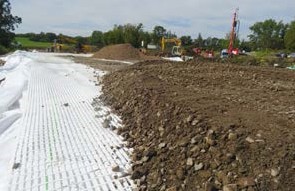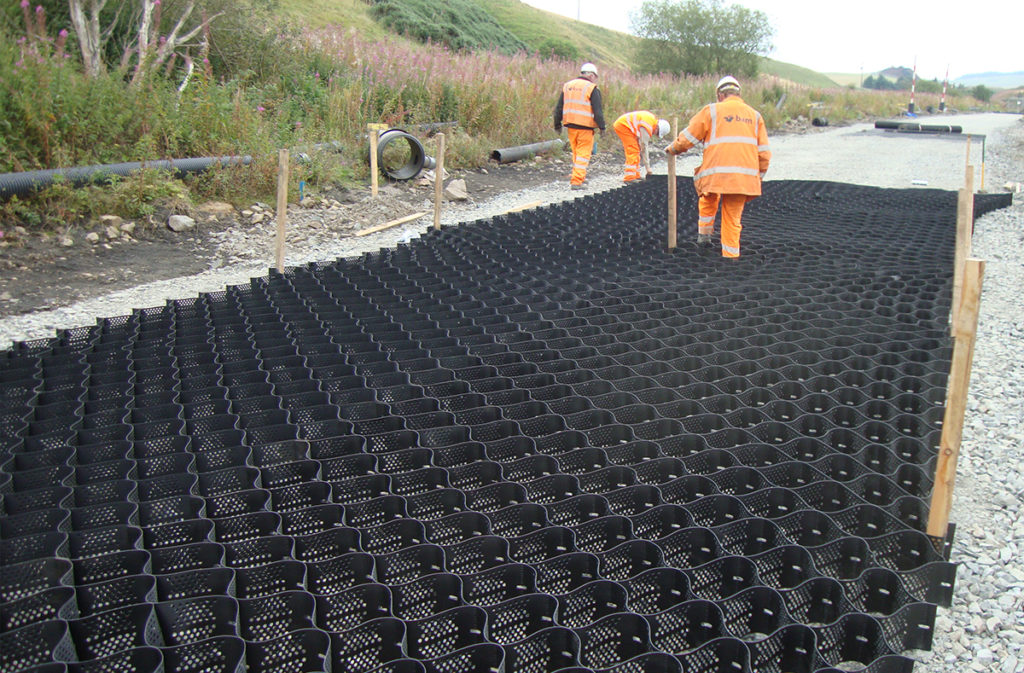NAUE geosynthetics secure German road embankment over old mining area
November 2nd, 2021
Photograph courtesy of NAUE The German federal highway B91 between the cities of Deuben and Werschen in Germany is a collector road with access to the A9 motorway. The subsoil risks resulting from past lignite mining activities represent an enormous challenge in the region. Subsidence has occurred regularly. Solution In the area of a bridge […]
Geosynthetics combine to create stiffened trackbed in Scotland
October 25th, 2021
Photograph courtesy of Greenfix UK and Presto GeoSystems The Borders Railway is the longest new domestic railway to be constructed in Britain in more than 100 years. Four new stations in Midlothian area and three in the Scottish Borders region have reduced journey times between Tweedbank and Edinburgh to less than one hour from nearly […]
Design of reinforcement geosynthetics in landfill piggyback expansion
June 1st, 2021
FIGURE 1 Installation of reinforcement geosynthetic An operator at a nonhazardous waste storage facility proposed extending the facility’s life, within the existing perimeter, by vertically expanding the cells in operation to a maximum thickness of waste of 52.5 feet (16 m). This project is based on nonhazardous waste storage cells 49.2-feet (15-m) thick, some of […]
NPA geocell for railway line repair in permafrost region
June 1st, 2021
FIGURE 1 Exposed degraded permafrost on the damaged track after the flood event in 2017 Churchill is a port city located on Hudson Bay in northern Manitoba, Canada. The nearest roadhead village of Gillam is 156 miles (252 km) south. Hudson Bay Railway (HBR), the only mode of land transport to Churchill, was completed in […]
Development of a new design method for geosynthetic-reinforced RPEs
April 1st, 2021
By Pietro Rimoldi and Nicola Brusa Rapid and extreme climate change is putting our planet under stress. As a consequence, in mountain and hilly regions, infrastructure and people are more often threatened by quick and unpredictable rockfall events. Falling boulders can have extremely high speeds, exceeding 11 mph (5 m/s) and up to 67 mph […]
Geomembranes for reinforcement?
April 1st, 2021
Q: We are using Robert Koerner’s Designing with Geosynthetics to calculate the required thickness of a geomembrane. See Figure 1 and Equation 1 from the book for details. Figure 1 Equation 1 Can you point us in the right direction with the mobilization distance, x? A: Yes, please see Figure 2 for high-density polyethylene (HDPE). […]
The GMA Techline
August 1st, 2020
Seaming dissimilar geomembranes Q: I kindly request your technical support in the questions below: A nonpolyethylene geomembrane was used in phase 1 of the tailings dam waterproofing system of a gold mine. For the expansion (phase 2), the use of a high-density polyethylene (HDPE) geomembrane is being evaluated. How can the HDPE geomembrane join the bituminous […]
Reinforcing dunes and bluffs with geosynthetics
October 1st, 2019
By Brian Maggi, Christopher D. P. Baxter, Aaron Bradshaw, Annette Grilli and Naser Al Naser The devastating effects of recent hurricanes and nor’easters highlight the need to improve the resilience of coastal communities. There is a trend toward implementing “soft” engineering solutions such as dunes reinforced with geotextile sand containers (GSCs) or coastal bluffs stabilized […]
Stabilization and reinforcement of wind farm access roads with geosynthetics
October 1st, 2019
This project is the construction of the first commercial-scale wind farm in North Carolina. It was for a renewable power generation facility providing clean energy. Constructing the wind farm required subgrade stabilization and reinforcement for more than 60 miles (97 km) of access roads that needed to be built in order to erect 104 turbines […]
HUESKER to sponsor webinar on soil reinforcement products
August 27th, 2019
HUESKER Inc. will host a free webinar, “Relevant Properties of Soil Reinforcement Products,” on Sept. 19, from 1:30 p.m. to 2:30 p.m. EDT. Geosynthetics can be manufactured from different polymers. The mechanical behavior of geosynthetic products depend on the material used for their fabrication. This webinar will address important concepts related to strength, stress/strain behavior […]
 TEXTILES.ORG
TEXTILES.ORG








